Expensive pink Candoglia marble rafted in from a quarry 60 miles away in the Lake Como area was used top to bottom in the Duomo’s construction which continued until 1810 with final touches added as late as 1965!
There was so, so much going on from every angle with all the statues and spires, it was hard to know where to look, and not simply see the forest instead of the trees within. On the right corner, we did see some intricate details that caught our eye: robed saints and a nude Atlas holding a corner buttress.
Steven always enjoys looking at gargoyles that function as drain spouts so he had 96 of them to admire if he so desired!
Finally, we made our way inside after a very short wait to
check our CDC Covid cards. The guard saw Steven looking for the cards in his neck pouch and jokingly said right away, "Oh, you must be from America!" Everyone in Europe seemed to have a Green
Pass accessible on their smartphones to prove they had been vaccinated. How we
wished the US also had a similar pass instead of a paper version that literally
any information could be written on as nothing on the card was verifiable.
Sorry for my rant of the day!
The 52, 100-ft.-tall sequoia-sized pillars represented the weeks of the year and the liturgical calendar. The pillars rose to support the ribbed, pointed arch ceiling.
At more than 500-ft. from the entrance to the stained-glass window at the far end, the Duomo’s nave was the fourth largest of any Christian church in the world. The apse, the area behind the altar, was begun in 1385.
A little red light on the cross high above the altar signified where a nail from Jesus’ cross was kept. The holy relic was brought to Milan in the fourth century when it was the capital of the western Roman empire by St. Helen, the mother of Emperor Constantine. Unfortunately, we had only recently missed viewing the relic on one of the three days in September each year when it is displayed.
The two single-stone pillars that flanked the main entrance were made from a single stone.
As the 600-year-old Duomo represented the unending line of bishops that presided over Milan beginning with St. Ambrose in the last half of the 4th century, it was filled with history. The 1,000-year-old gray stone coffin honored the formidable 11th-century Archbishop Aribert.
A few steps further on in the right nave was a red coffin that belonged to the noble Visconti family who commissioned the church.
The plaque traced the uninterrupted rule of 144 archbishops beginning in 51 AD.
The expensive 15th-century stained-glass windows above it were purchased by wealthy families hoping to curry favor with the church. Facing south to achieve the most light, the windows were designed to teach the illiterate masses the way to salvation through stories from the Old Testament and the life of Jesus.
They showed some familiar scenes: Cain killing his brother, the flood, and Noah’s drunkenness.
Many of the windows were made of dimmer and cheaper painted glass from the 16th to the 20th-century or were replacements for those destroyed when WW II bombs fell nearby. This window, though, dated from 1470 just 85 years after the first stone was laid. It showed Jesus’ story from Annunciation to Crucifixion. In one of the scenes, the angel Gabriel announces the news to Mary while the dove, representing the Holy Spirit, enters her window and world.
A much brighter window from the 1980s celebrated two local cardinals whose tombs and bodies were behind glass. The memorials honored Cardinal Ferrari and Cardinal Schuster who helped the Milanese, the people of Milan, after WW II. As such, they were a reminder that the Duomo wasn’t simply a tourist attraction but a living testament to the city.
The light pouring in through the stained-glass windows cast stunning shadows on the pillars just as it did at La Sagrada Familia in Barcelona.
The altar was anchored by a domed tabernacle atop columns and flanked by two silver statues of famous bishops. One was the powerful 4th-century St. Ambrose who became the city’s patron saint after putting Milan on the map.
The other was St. Charles Borromeo who transformed the cathedral in the 16th-century after inheriting a half-unfinished cathedral. He re-energized the project and commissioned the tabernacle. As a great champion of the Church and to counter the Protestant Reformation movement taking place against the Church, Borromeo designed the stage-like altar that was the same style as the Vatican in the 1570s.
I happened to glance back to take a second look at what sure looked like carved tracery on the ceiling ribs. Was I fooled or what when I realized that the 'carving' was actually painted because it was far less expensive than carved stone!
The grotesque, 16th-century statue of the martyr and 1st-century apostle St. Bartolomeo definitely was not what we were expecting to see in the Duomo! It showed him skinned alive by the Romans, wearing his skin like a robe while piously holding a Bible in one hand. The study in human anatomy, carved by a student of da Vinci’s, was only made possible by learning about dissection, a practice forbidden by the Church at the time.
As gruesome as it was, it was also riveting to look at the incredible details in the hands and legs.
The Latin inscription at the base translated to "I was not made by Praxiteles (aka the classical master of beautiful nudes) but by Marco d'Agrate." Guess we now knew who was Leonardi's student!
Though the three windows in the apse were gorgeous, they were 19th-century painted glass as the originals had been destroyed in Napoleon’s era. There were 144 separate scenes as each window had a dozen panels and a dozen rows.
Having just left Lake Como that morning, it was neat to see the exceptional 16th-century inlaid marble floor. The black marble had been quarried from the lake area. It was harder and more durable than the white marble from Lake Maggiore, Naomi, or the tawny marble from Verona.
We could really feel the indentations in the different marbles. I tried to show that in this photo but it didn't turn out as well as I had hoped so you'll just have to take my word for it!
Near the entrance was the baptismal font made out of very expensive purple porphyry by Borromeo’s favorite architect, Pellegrini.
Down in the Archaeological Annex was a maze of ruined brick foundations from earlier churches that used to occupy this location as the city was an important center of Christianity right from the beginning. These stones and mosaics and even the pavement we walked on dated from the time of the Edict of Milan in 313 AD when Emperor Constantine made Christianity legal in the Roman Empire when he ruled from the city.
The highlight was the barely visible remains of the octagonal Paleo-Christian Baptistery of San Giovanni by a small church. Centuries ago, people couldn't enter the church until they were baptized at the age of 18. St. Ambrose was baptized in the humble baptistery and, after later becoming an archbishop, baptized 31-year-old Augustine of Hippo who went on to become one of the world’s most influential writers, philosophers, and thinkers.
The large number of coffins and sarcophagi found by the baptistery emphasized the importance given to placing tombs close to sacred buildings for the deceased's salvation of souls during the Middle Ages. This privilege was generally reserved for eminent members of the ecclesiastical hierarchy or prominent laypeople.
After someone mentioned that the most favorite part of their visit to the Duomo was walking among the frilly spires on the rooftop terraces, that was enough for us to give it a go even though it meant climbing up a huge amount of stairs!

You can see how the 135 spires tapered into a slender point and then were topped by a saint gazing out over the city.
Do I ever remember thinking how puny we were compared to the towering, spindly spires!
Twenty stories below us was the enormous Piazza del Duomo!
At the very top of the tallest spire was the large golden statue of the Madonna of the Nativity, to whom the church had been dedicated. She was so tall we hadn't been able to spot her from the square.
This was probably my favorite shot of the day except it meant having to climb on a slanting staircase directly above the nave which gave me the willies!
Climbing up a couple more levels brought us some marvelous panoramic views of Milan's skyline looking north over the city. The UniCredit Tower with its 750-ft.-high spire from 2011 is Italy's tallest building and represented Milan's future.
No wonder we were all smiles being back on terra firms again!
Next post: The treasures from Milan's Duomo in its museum and La Scala Opera House.
Posted on November 21st, 2021, from Dublin, Ireland, just hours before flying home to Colorado for Thanksgiving after nine exciting weeks bopping around Belgium, Germany for a couple of days, Switzerland including tiny Liechtenstein for a few hours, and Italy.

















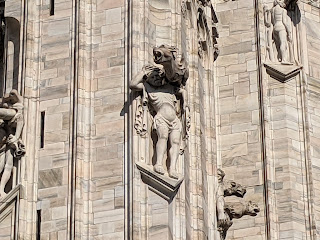































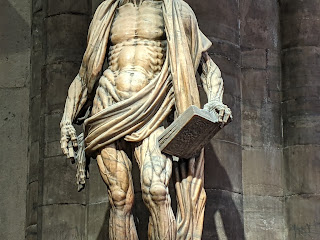







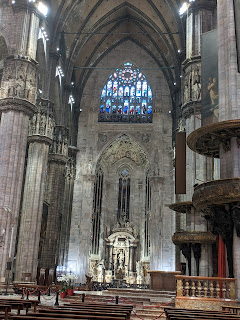



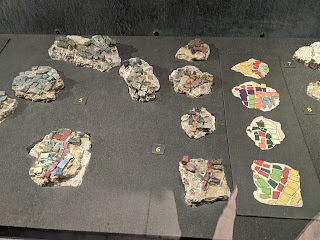
















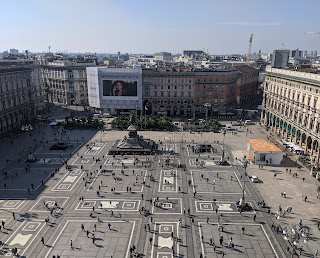



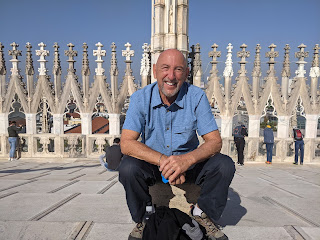






The prickly-spired "Duomo di Milano" is truly spectacular especially against a brilliant blue skies. Hope you had a seamless travel day home and Happy Thanksgiving to you and yours. xo
ReplyDeleteGlad you also enjoyed seeing the spectacular Duomo, Lina.
DeleteThe stained glass windows are beautiful. Beautiful Church. What wonderful views from the top after a long hike up the stairs, not sure if I could do it. Janina
ReplyDeleteI bet you and Pat could make the trek up the stairs to the Duomo rooftop as I think there was an elevator at least partway up and the views so well worth the hike!
Delete